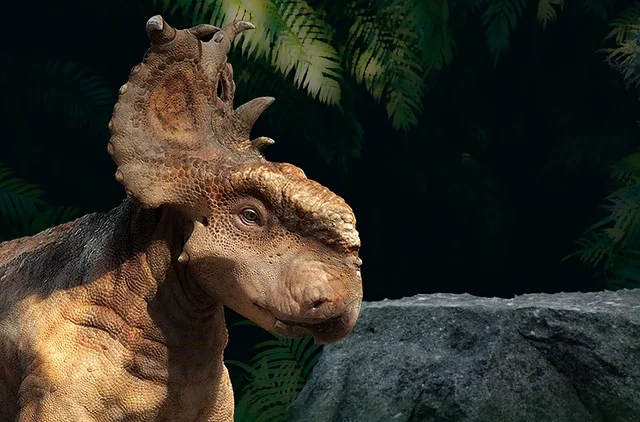Triceratops are amazing dinosaurs from the past. Today, only a few fossil remains are found in the earth’s bowels, and reconstructions of skeletons from exhibition halls of museums remind us of their existence.
And yet, scientists around the world are striving to study these ancient reptiles to the smallest detail, to learn the secrets of their forever lost world. They managed to learn a lot, even classify different species. Triceratops lived in North America at the very end of the Cretaceous, about 67 million years ago.
Interesting facts of Triceratops
- Due to their memorable appearance, Triceratops is one of the most recognizable dinosaurs. They walked on four legs, due to which they had stability, but were unable to run fast. The characteristic features of these dinosaurs were three horns on the muzzle and a bone collar that served for defence.
- Individuals of this species had massive thick limbs and a body, which could reach 10 tons. The head’s low position and the jaw structure suggest that Triceratops ate mainly low-growing plants, possibly ferns, cycads, or palms.

- The first sample of the remains of a Triceratops was found in 1887 and was mistakenly attributed to the bones of an unusually large bison. The largest Triceratops skull found is 2.2 meters long. The animal’s head was 2/3 of the entire body.
- Researchers have not yet found the complete Triceratops skeleton, but it was possible to recreate it using computer modeling based on fragmentary findings. Norman Boss did this detailed work. The result of his efforts was a reconstruction, presented in 1905 at the Smithsonian National Museum.
- One of the last remains of a Triceratops was found in Wyoming in 2002. This specimen is now known under the code name “Lane” and has interested paleontologists in its clear imprints of skin fragments.
- Triceratops’s mouth looked more like a parrot’s beak than an animal’s mouth, and the structure of its body from modern animals most of all resembles the figure of a rhinoceros. There were about 800 teeth in his mouth, and not all of them were active; some were needed “in reserve.” The teeth were located as close to the pharynx as possible, and the beak, which ended the jaws, was toothless. Chewing plant food thoroughly, this dinosaur was able to move its jaws not only up and down, but also left and right.
- It is believed that Triceratops could have served as food for Tyrannosaurus, another famous prehistoric predator. However, the massive carcass and three large horny processes were hardly easy prey for him. Among scientists, Triceratops even earned the nickname “tank of the Mesozoic era” because of its impressive size and enormous strength.
- There is a theory that Triceratops were herd animals with a very clear system of subordination in the group. At the same time, the step occupied by an individual was determined by the color of the bone collar – the brighter it is, the higher the status of its owner.
- Fossilized dinosaur bones are very popular with collectors. In 2008, one of the finds was sold for $ 1 million to a private person. However, later this bone was donated to the Boston Science Museum.
- Triceratops became extinct 67-68 million years ago at the end of the Mesozoic era, so it could well have been the last species that went extinct. The Triceratops image is now actively used by toy developers. For example, in the line of transformers, there is an Autobot capable of taking the form of this dinosaur.
